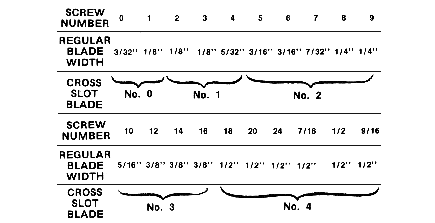Quality screwdrivers are judged by the kind of metal in the blade, finish and amount of grinding on the tip. Material used in the handle and bar attachment to the handle are other quality indicators.
If blade metal is poor quality, it will chip and crumble under pressure. If the tip is improperly ground and flares too much, it will rise out of the screw slot. If the blade is not attached firmly to the handle, it will eventually loosen and slip in the handle.

SCREWDRIVER TIPS
Several types of screwdriver tips are available-regular, cabinet, Phillips, Frearson, Torx, clutch- head, hex, Bristol multi-spline and square-tipped.
Regular tips are used with large, heavy screws. Tip is flared so it is wider than the driver bar. Quality drivers with regular tips should be accurately ground for uniformity. Blades should not taper too sharply from the tip, because an improperly tapered tip has a tendency to rise out of the screw slot.
Cabinet tips are similar to regular tips, but have no flare. They are straight for use with small screws and countersinking screws where regular tips with a flare would mar the wood or material on the side.
Phillips-head drivers are used on cross-slotted screw heads with modified U-shaped slots of uniform width. Screws of this type are often found on automobile trim and electric appliances. Sizes range from 0 to 4, with 0 being the smallest.
Frearson screw heads are similar to Phillips. They have cross-slots, but they are V-shaped slots with tapered sides. While a cross-slotted driver will fit many sizes of the type of screw for which it is intended, it is best to use drivers of the proper sizes. (See accompanying table).
Torx drive system provides six lobular drive surfaces mated from lobes of the driving and driven elements. Drive surfaces have vertical sides that permit the maximum torque application to assure reliable clamping force. All driving torque is transmitted as a perpendicular force to the driven element so there is no cam-out.
Clutch-head tips have four points of contact. They lock into the screw head when turned counterclockwise. The driver is unlocked by turning it in the opposite direction. Because of the many contact points, the tip will not damage the screw head.
Hex (hexagonal) tips are used in repair work in the electronics field, particularly in radio and television repair. They are used to tighten socket-set screws and usually come in sets. Some sets are attached to and fold into a metal carrying case. Other variations include T-shaped hex tools with vinyl grips and L-shaped keys for greater torque power.
Bristol multi-spline tips are the least common, with six points of contact. They allow torque to be applied evenly with minimum danger of damaging the screw head.
Square-tipped (Robertson type) screwdrivers come in five tip sizes for recess screws found in recreational vehicles and in furniture.
Multi-bit screwdrivers allow the user to have a number of different types of tips in one tool. Some products keep the interchangeable bits in a self-contained unit.
Offset screwdrivers are designed for removing and inserting screws in places where it is impossible to use a straight-shank screwdriver. They are available in many combinations of slotted and Phillips-head tips and with ratchet-type mechanisms.
Many screwdrivers have magnetized tips, convenient when guiding screws to holes or otherwise inaccessible areas. They also retrieve dropped screws and nuts. Others have split points that can be expanded in width to fill the screw slot and hold screws when guiding into inaccessible areas. A spring clamp that fits over the screw head, holding the bit in the slot, serves a similar purpose.

SCREWDRIVER HANDLES
Handles are made of wood or plastic. Top-quality wooden handles have a bolster on the screwdriver bar which helps hold the bar to the handle. The one piece bars in heavy-duty wooden handles extend through the handle and are headed over on the end with a metal cap. Plastic handles should be made of fire and heat-resistant materials. If properly designed, they give excellent grip. Rubber or vinyl is often used as a non-slip or insulating cover on plastic handles.
SPECIALTY SCREWDRIVERS
This group includes offset screwdrivers, used in places impossible to reach with ordinary drivers; screwdrivers with external screw-gripper or screw-holder blades to start screws in hard-to-reach spots; and offset screwdrivers with ratchets.
HEX-NUT DRIVERS
Hex-nut drivers are similar to screwdrivers, but have tips more like wrench sockets than screw tips. They are used mainly on small nuts and in confined areas such as electronic equipment, instruments and car ignitions. They come in several sizes and styles, with a fixed-size or variable-size “socket” at the end to adjust to various nut sizes.
SPIRAL-RATCHET SCREWDRIVERS
A spiral-ratchet screwdriver uses a mechanism similar to a push-pull drill. It has an adjustable chuck to permit interchanging different size driver tips and drill points. Ratchets are designed to drill and remove screws. Driving action is provided by pushing straight down on the handle.
HIGH-TORQUE RATCHET SCREWDRIVERS
These screwdrivers feature a 360° ball as a handle with a ratchet mechanism that eliminates the need to grip and re-grip during the driving process. The wider gripping surface generates more torque than conventional screwdrivers. The amount of additional torque varies with the model. These high-torque ratchet screwdrivers come with interchangeable blades.
Check your state and local codes before starting any project. Follow all safety precautions. Information in this document has been furnished by the North American Retail Hardware Association (NRHA) and associated contributors. Every effort has been made to ensure accuracy and safety. Neither NRHA, any contributor nor the retailer can be held responsible for damages or injuries resulting from the use of the information in this document.

